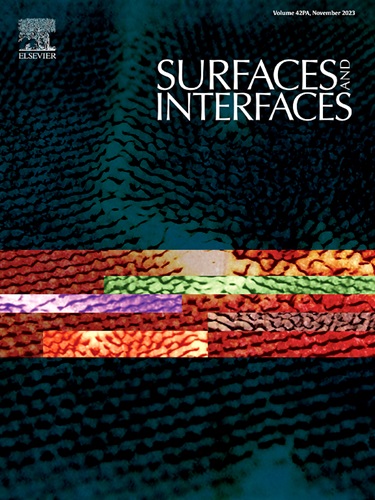Noncovalently functionalized hexagonal boron nitride nanosheets of poly(m-aminophenol) by enhanced corrosion protection of epoxy coating
IF 5.7
2区 材料科学
Q2 CHEMISTRY, PHYSICAL
引用次数: 0
Abstract
The incorporation of nanomaterials into epoxy coatings can significantly enhance their barrier properties. Hexagonal boron nitride (h-BN) demonstrates considerable potential for application in prevention of metal corrosion due to its excellent electrical insulation and outstanding barrier characteristics. However, the h-BN has been observed to exhibit poor dispersion within epoxy resin. In this study, h-BN/PmAP were prepared by non-covalent functionalization of h-BN nanosheets with PmAP in order to strengthen the coating corrosion protection. The coating containing 1 wt% h-BN/PmAP-10 showed a notable enhancement in long-term corrosion protection. 25 days of immersion in 3.5 wt% NaCl later, the modulus value (|Z|0.01 Hz) of h-BN/PmAP-10/EP was maintained at 1.60 × 107 Ω.cm2, which is two orders of magnitude than that of the pure epoxy resin (1.28 × 105 Ω.cm2). And from the Tafel plot of h-BN/PmAP-10/EP, the corrosion current is (Icorr = 4.68 × 10-10 A/cm2) nearly three orders of magnitude lower than that of pure epoxy resin (Icorr = 1.30 × 10-7 A/cm2). The main mechanism underlying these improvements is attributed to the enhanced dispersion of h-BN/PmAP-10 in the coating, which improves the densification of the coating and creates a ‘labyrinth effect’. It also retains the corrosion inhibition ability of PmAP, this helps the coating to resist corrosion.

求助全文
约1分钟内获得全文
求助全文
来源期刊

Surfaces and Interfaces
Chemistry-General Chemistry
CiteScore
8.50
自引率
6.50%
发文量
753
审稿时长
35 days
期刊介绍:
The aim of the journal is to provide a respectful outlet for ''sound science'' papers in all research areas on surfaces and interfaces. We define sound science papers as papers that describe new and well-executed research, but that do not necessarily provide brand new insights or are merely a description of research results.
Surfaces and Interfaces publishes research papers in all fields of surface science which may not always find the right home on first submission to our Elsevier sister journals (Applied Surface, Surface and Coatings Technology, Thin Solid Films)
 求助内容:
求助内容: 应助结果提醒方式:
应助结果提醒方式:


